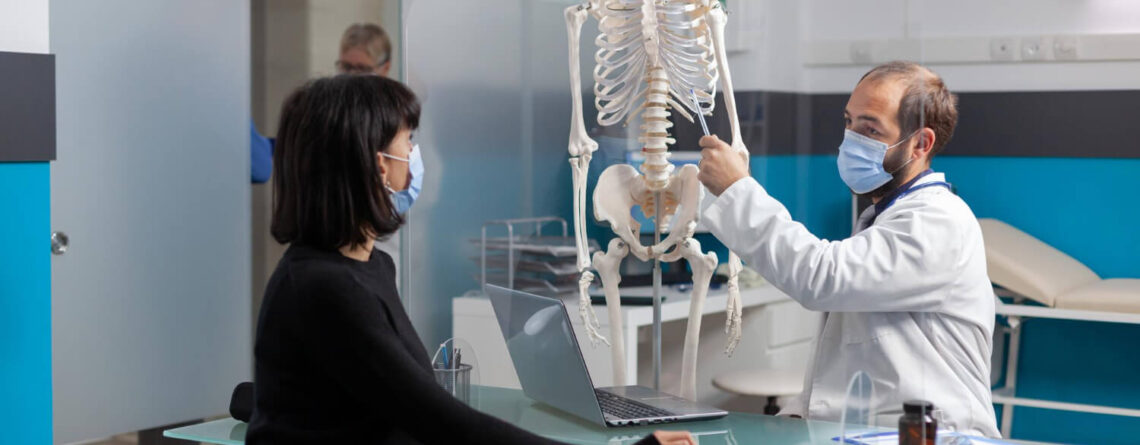Bone sarcomas and other primary oncological neoplasms of bone tissue in adulthood are quite rare and account for 0.2-0.5% of all oncological neoplasms. Men and women get sick with the same frequency. In recent years there has been a decrease in the incidence of this location tumors: in Ukraine, this indicator has decreased by 1.8 times.
Among primary bone lesions, malignant tumors still predominate, benign tumors occur 2-3 times less often. Predominant localization of all bone tissue primary neoplasms is limbs long tubular bones ((up to 70% of cases)). Кістки ніг уражуються в 2,5 рази частіше, ніж кістки рук. Первинні злоякісні пухлини кісток реєструють переважно у віці до 40 років, після 60 років.
The most common types of primary malignant bone tumors are osteosarcoma, chondrosarcoma, and Ewing's sarcoma. In remaining cases, as a rule, doctors are dealing with fibrosarcoma, malignant fibrous histiocytoma.
In adults, especially in people over the age of 40, metastatic tumorssecondary) are noted 100 times more often than primary malignant tumors. Except for tumors from bone marrow cells (for example, multiple myeloma). Multiple myeloma is often considered a bone marrow tumor within bone tissue rather than a primary malignant bone tumor because it is of hematopoietic origin.

Наша клініка працює в тісній та плідній кооперації з найкращими ізраїльськими онкологічними центрами, за зразок надання медичних послуг ми обрали саме ізраїльську медицину, як одну з найефективніших у світі. Кожен окремий клінічний випадок пухлини кісткової тканини ведеться спільно лікуючим лікарем, the head of the department – Dr. Iryna Stefanska and responsible oncologist directly from Israel. Thanks to such a professional team work, it is possible to achieve success even in the most difficult clinical situations.
The Maimonides Medical Center works under the patronage of “Keren Or for our Child” the Charitable Foundation, so all patients who need expensive treatment, but cannot afford it, can count on partial or full payment of medical services by this foundation.
Types of bone tumors in adults
Bone tissue tumors are divided into benign and malignant, and they are also primary (growing directly from bone structures) and secondary (metastases of other malignant tumors into bones).
Among benign tumors of bone tissue, the most common are:
- Aneurysmal bone cyst is a gradually enlarging mass that usually appears before the age of 25 . This is a cystic lesion that develops, as a rule, in metaphyses of long tubular bones. Symptoms include pain and local swelling. The most successful treatment method is surgical removal of the entire affected area.
- Benign giant cell tumor of the bone – most often affects people aged 20-30 , such malformations occur in epiphyses and distal metaphyseal-epiphyseal regions. These tumors are considered locally destructive. They continue to grow, destroying bone, can eventually destroy all bone tissue and spread to soft tissues. Such tumors often recur after treatment.
In isolated cases, a bone giant cell tumor can metastasize to lungs. A biopsy is required to confirm the diagnosis. Treatment is complex, often with immunobiological drugs application. - Chondroblastoma is a rare tumor that most often develops in people aged 10 to 20 years . Arising in epiphysis, it can grow and destroy bone and adjacent joint. Tumor is removed surgically. Frequency of local recurrence is from 10 to 20%.
- Chondromyxoid fibroma is very rare and usually occurs before the age of 30. The proximal part of tibia and wing of ilium are typical locations. After biopsy, chondromyxoid fibroma treatment consists of surgical excision or curettage and bone grafting.
- Enchondroma can occur at any age, but is more common in people aged 10 to 40 years . They are usually located in metaphyseal diaphyseal region inside bone marrow canal. These tumors are usually asymptomatic, but can grow and cause pain. They are often found accidentally during X-ray examinations performed for other reasons.
Asymptomatic enchondroma does not require biopsy, removal, or other treatment, but a differential diagnosis with rare but malignant tumor chondrosarcoma is required. - Non-ossifying fibroma ((fibrous cortical defect, fibroxanthoma)is bone benign fibrous neoplasm. They usually occur in metaphyses area, especially often in thigh distal part, in distal and proximal parts of tibia. They can progressively increase and become multifocal. Small non-ossifying fibroids are asymptomatic. However, when about 50% of bone diameter is involved, pain appears and risk of pathological fractures increases.
Non-ossifying fibroids are usually discovered accidentally during instrumental examination (for example, after injury). Small non-ossifying fibroids do not require treatment, but patient should be monitored. Defects that cause pain and are more than 50% of bone diameter are an indication for removal and bone transplantation, which allows to reduce pathological fracture risks. - Osteoid osteoma is most common in young people (usually between the ages of 10 and 35) in long bones, but can occur in any bone of skeleton. Characteristic pains that usually worsen at night. CT or MRI, which are the most informative diagnostic methods are performing. Ablation of pathological focus within a small zone using transcutaneous radiofrequency energy in most cases gives favorable results. Rarely, these tumors are removed surgically.
- Osteoblastoma is a rare benign tumor that consists of tissue histologically similar to osteoid osteoma. Osteoblastoma is much more common in men, usually between the ages of 10 and 35.
Tumor develops in bones of spine, lower leg, hands and feet. It is a slow-growing tumor that has ability to destroy normal bone. Visualization is carried out by conventional radiography, CT and MRI. Usually, an open biopsy serves as basis for making an accurate diagnosis. Treatment requires surgical intervention. - Osteochondroma is the most common benign bone tumor with possible localization in any bone, but most often in long bones epiphyses.
Most often, they occur in people aged 10 to 20 years , they are both single and multiple. There is a family predisposition to multiple osteochondromas development. Removal is conducted if tumor compresses a large nerve or vessel, causes pain, disrupts growth, or has a destructive appearance on imaging, suggesting a malignant chondrosarcoma. - Osteoma is an area of uniformly dense bone that is benign. They are most common in skull bone and area around nasal bones and are rarely found in axial skeleton or pelvis. Small osteomas are called bone islands. They are not painful and are often found accidentally on an X-ray.
Diagnosis is established on basis of X-ray examination data. In case of doubtful diagnosis, an MRI study will help. Osteomas do not require a biopsy.
Among malignant tumors of bone tissue , the most common are:
- Multiple myeloma is the most common primary malignant bone tumor, but is often considered a tumor of bone marrow cells within bone rather than a primary bone tumor because it is of hematopoietic origin. Even if multiple myeloma is considered a hematologic tumor, detected skeletal abnormality must be differentiated from other bone tumors. Multiple myeloma occurs mainly in older people. Bone changes are well treated with radiation therapy.
- Osteosarcoma (osteogenic sarcoma)is the most common malignant primary bone tumor (if myeloma considers bone marrow cells tumor rather than a primary bone tumor) and is highly aggressive. It most often occurs between the ages of 10 and 25 , although it can develop at any age. There is a genetic predisposition, especially in children who are carriers of hereditary retinoblastoma gene (RB1 gene variants)and Li-Fraumeni syndrome (TP53 gene).
Osteosarcoma produces malignant osteoid (immature bone) from tumor bone cells. It usually develops in knee joint region (in thigh distal part more often than in tibia proximal part) or in other long bones, especially in metaphyseal-diaphyseal region and can metastasize, usually in lungs or other bones.
Typical symptoms are pain and swelling in the affected area. - Adamantinoma – occurs rarely (<1% of malignant bone tumors) and most often develops in lower leg. Usually, tumor affects teenagers and people in their 20s , but it can be registered at any age. Adamantinoma develops slowly and in most cases manifests itself in form of pain and local swelling. Metastasis can occur, mainly in lungs, but is quite rare. Adamantinoma treatment consists in its large resection and bone defect restoration. In some cases, amputation is performed.
- Chondrosarcoma is a malignant tumor of cartilage tissue. They differ from osteosarcoma in a clinical view point, therapeutic methods and prognostic factors. 90% of all chondrosarcomas are primary.
Chondrosarcomas most often appear in elderly. They often develop in flat bones (for example, pelvis, scapula), but can develop in any part of any bone (among long bones, femur and humerus are most often affected). - Chordoma is a rare tumor that develops from remnants of embryonic chord. This tumor is most often localized in spine end sections, usually in area of sacrum or near skull base.
Chordoma of sacrococcygeal region causes almost constant pain. With a chordoma at skull base, symptoms of damage to cranial nerves, more often oculomotor nerves, are possible.
Symptoms of chordoma can appear for months or even years before a diagnosis is made. If tumor is located in sacrococcygeal area, radical removal is often possible. Skull base chordomas are usually not amenable to removal, but may respond to radiation therapy. - Ewing's sarcoma of bone is a bone tumor represented by small, round malignant cells, with a peak incidence between 10 and 20 years of age . It mainly affects limbs bones, although it can be noted in any other bones. Ewing's sarcoma tends to spread significantly, sometimes involving the entire bone. The most common symptoms are pain and swelling in affected area. Tumor treatment includes various combinations of surgery, chemotherapy, and radiation therapy.
- Fibrosarcoma and undifferentiated pleomorphic sarcoma (malignant fibrous histiocytoma of bone) – these tumors are similar in characteristics to osteosarcomas, but produce fibrous tumor cells, affect the same age group, and cause similar problems. Treatment and outcome for marked changes are similar to those for osteosarcoma.
- Lymphoma of bone (formerly known as reticulosarcoma) affects adults, usually between the ages of 40 and 50. As a rule, this is a diffuse large B-cell lymphoma. It can occur in any bone. It can develop as a primary bone tumor, in combination with similar tumors of other tissues, or as a metastasis of a known lymphoproliferative disease.
Pain and swelling are common symptoms of bone lymphoma. Pathological bone fractures are also common. Bone lymphomas are usually treated with systemic chemotherapy. - Malignant giant cell tumor is rare and is usually localized at the end of one of skeleton long bones. A malignant giant cell tumor that developed from a previous benign giant cell tumor is characterized by resistance to radiation therapy. MRI and biopsy are performed to establish the diagnosis. Treatment of malignant giant cell tumor is the same as for osteosarcoma.
- Metastatic bone lesions are 100 times more common than primary malignant lesions. Any malignant tumor can metastasize to bones, but most often this happens with cancer of breast, lungs, prostate, kidneys, thyroid gland, colon. Metastases are manifested by pain in bones, although they may remain asymptomatic for some time. Symptoms of bone metastases may appear earlier than clinical manifestations of primary tumor, or develop in patients with an established diagnosis of malignant neoplasm.

Symptoms of bone tumors in adults
Unfortunately, there are no specific signs of tumor process development inside bone. It is necessary to suspect something in following cases:
- persistent pain syndrome in bones or joints area;
- swelling in bone certain area, "bulge" presence where it should not be;
- impairment of limb function, for example, mobility limitation;
- limping on one leg;
- sparing a certain limb;
- frequent fractures, fractures without significant applied force should be especially alarming, for example, falling from a height of one's own height.
If you notice one or more signs, contact doctors of our clinic for help. Specialist will examine patient carefully, disprove his fears if there is no problem, and make up necessary follow-up plan if there is a suspicion of a bone tissue neoplasm.
Diagnostic methods of bone tissue tumors
The basic rule of diagnosis in oncology: the earlier diagnosis of malignant tumor is established, the better prognosis and treatment result.
Therefore, high-quality and quick diagnosis is an extremely important stage. Maimonides Clinic uses only modern, expert-class equipment, all our doctors are perfectly mastered all methods of examining a patient with suspected bone tissue malignant neoplasms, are able to interpret received data correctly, which helps them to create a modern, individual and effective treatment plan.
Diagnostic program includes the following examinations:
- X-ray is the main routine method of detecting bone tissue neoplasms.
- At the next stage of imaging diagnostics, MRI with or without contrast is used, sometimes CT may be needed.
- Scanning of the whole skeleton (bone scintigraphy) or whole body PET-CT, PET-MRI (positron emission tomography in combination with CT or MRI) when multifocal or metastatic tumors are suspected.
- Neoplasm biopsyif imaging studies do not clearly show benign features or if there are multiple bone lesions consistent with metastatic disease in a patient with confirmed active primary cancer.
We send all biopsy specimens obtained after this procedure to the world's best pathogistological laboratories (Israel, Germany, USA).Thanks to such double checks, we are absolutely sure of diagnosis correctness and effectiveness of the selected treatment tactics.
Innovative molecular genetic tests to our patients after biopsy. . This is a mandatory part of modern diagnosis of oncological diseases. Thanks to molecular genetic diagnostics, we can choose the most effective treatment regimens, because the response to certain drugs action depends on the type of malignant changes.
An example of such modern diagnostics are test systems for molecular genetic testing. Such as the Foundation One and Caris Molecular Testing. These tests make it possible to determine certain types of mutations in tumor cells, as well as certain receptors presence on the surface of these parasitic cells. These data are subsequently used to create individual immunobiological therapy drugs or to select target therapy drugs. In modern medicine this approach is called personalized oncology. Our patients have access to all this benefits of this innovative treatment.

Bone tissue tumors modern treatment
One of the most important advantages of bone tissue tumor treatment at Maimonides Medical Center is a comprehensive treatment approach application. Struggling against tumor, doctor uses the entire available arsenal of methods. Therapy is always a combination of two, three, or even more methods. As a rule, treatment regimen includes tumor surgical removal in combination with chemotherapy and radiation therapy. In some cases, certain innovative treatment methods are added to treatment program (targeted drugs, immunobiological drugs, etc.).
For patients with oncological bone lesions, the most modern surgical procedures are available in process of complex treatment. All surgical interventions are performed according to organ-sparing surgery principles. That is, amputations are performed only in extreme cases, when there is no possibility to save the limb.
Modern surgical procedures in patients with bone tumors:
- vertebroplasty and osteoplasty under computer navigation control;
- cryoresection of bone tissue tumors;
- excochleation of bone tissue cystic neoplasms;
- microsurgical reconstruction of blood vessels, bones and soft tissues;
- radiofrequency thermal ablation of bones and soft tissues tumor lesions;
- and other high-tech, minimally invasive effective methods.
If in treatment course it is necessary to amputate affected limb or other skeleton affected part in order to save the patient's life, then in future reconstructive and plastic surgeries , modern interventions for affected joints endoprosthesis must be performed.
Such innovative procedures make it possible to restore formed tissue defect that arose after initial stage of surgical treatment. An example of such surgery is sternum and ribs, individual vertebrae, pelvic bones, etc prosthetics. Bone grafts are made in accordance with individual needs of each person using the most modern technologies, for example, printing on 3D printers, replacement with special bone cements, etc.
Stereotaxic radiosurgery is also actively used in oncological orthopedics. If tumor location does not allow its removal, or patient is contraindicated for surgical intervention, neoplasm is removed by stereotaxic radiosurgery method – an innovative technique, after which 80% of patients improve.
During the session, there is no pain, effect is carried out non-invasively by pathological tissues radiating with high doses of radiation. In our clinic, this procedure is performed on innovative CyberKnife radiosurgical system, (CyberKnife), which allows using the highest doses of radiation as accurately as possible. Before procedure, a three-dimensional computer simulation of malignant neoplasm is performed, rays direction is programmed so that they cover the entire area of tumor, but do not affect healthy tissues. Ionizing rays pass through healthy tissues at different angles, each beam does not carry a large radiation load. They converge in neoplasm, where their power is summed up. This allows for a few sessions to significantly reduce tumor volume or completely destroy it.
Radiation therapy is used in complex treatment after surgery, which helps to reduce relapses number, as well as in case of bone tissue metastatic lesions or in case of inoperable primary tumors. Early radiation (from a single session of 8 Gy to multiple sessions of up to 30 Gy) and bisphosphonates (for instance, zoledronate, pamidronate) or denosumab slow bone destruction. Some tumors respond better to radiation therapy, and some are not sensitive to radiation, unfortunately.
Chemotherapy application in complex treatment increases 5-year survival from 20% to more than 65%. Neoadjuvant chemotherapy is performed before surgical resection. After several courses of chemotherapy (over the course of several months), a gentle removal of the tumor and reconstruction of the limb are performed. All chemotherapy drugs used by our patients are produced by well-known global pharmaceutical concerns. Thus, we are sure of the safety of the drugs used and their effectiveness.
Targeted therapy is an innovative method of drug treatment for cancer, which has shown its effectiveness, especially in combination with other methods of therapy. It is based on the selective effect of drugs only on cancer cells. Thanks to this, it is possible to stop the growth and division of cancer cells throughout the body, while there is no effect on healthy surrounding tissues.
In each case, the decision on the combination of certain treatment methods is made jointly by a team of specialists. Each patient and his disease is different, so our doctors, relying on their experience in the treatment of bone tissue tumors, often go beyond the standard protocols, changing the treatment regimens and doses of the necessary drugs, the radiation technique in order to get the best possible results for their patients.

